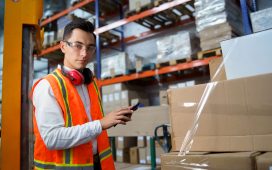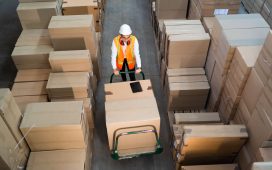In this Q&A, Sateesh Seetharamiah from EdgeVerve discusses the challenges faced by UK SMEs due to supply chain delays and how TradeEdge, an intelligent supply chain management platform, addresses these issues. Sateesh shares insights on how TradeEdge has helped companies like Mars and a global consumer goods conglomerate improve their supply chain operations. He also talks about the future of supply chain management in the UK and the role of platforms like TradeEdge in shaping this landscape.

What are the main factors contributing to the £1.9 billion loss in income for UK SMEs due to supply chain delays, and how does TradeEdge address these challenges?
The staggering £1.9 billion loss in income for UK SMEs is largely attributed to increased operational costs, project delays, and challenges in securing new business deals. Sectors such as wholesale, retail, and franchising have been especially impacted. TradeEdge, as an intelligent supply chain management platform, is designed to tackle these issues head-on. Utilizing AI and automation, TradeEdge provides businesses with unparalleled channel visibility, enhanced retail execution, and the capability for quicker market penetration. The platform’s near real-time demand sensing and seamless data harmonization features empower businesses to refine their demand planning strategies, thereby adapting more effectively to fluctuating market conditions.
Can you provide more details on how TradeEdge helped Mars reduce traceability time from 4 days to 2 hours?
Mars faced a critical issue with product recalls, which were frequent and costly due to data siloes and limited visibility across its supply chain. We implemented TradeEdge Product Traceability, a cloud-based solution that integrates data from various ERP/WMS systems in near real-time. This gave Mars a unified view of product movement down to the pallet level. A key feature is our collaborative compliance reporting dashboard, which enabled Mars to manage its hold and release process more efficiently. The result dramatically reduced traceability time from 4 days to just 2 hours, enhancing Mar’s brand resiliency and compliance measures. This solution directly addressed Mar’s challenges, offering them a more agile and responsive supply chain.
How has TradeEdge assisted the global consumer goods conglomerate in strengthening its demand planning by connecting 2300+ partners across 35 countries?
Our client, a global consumer goods conglomerate, grappled with fragmented data and inconsistent quality, making demand planning a herculean task. We deployed TradeEdge, our cloud-based platform, to acquire and harmonize channel performance data in near-real time. This gave the client a unified view of their distribution network, spanning 2300+ partners across 35 countries. Our shared services team expedited new partner onboarding and ensured timely, accurate data submissions. The result was a 90% reduction in data acquisition efforts and a significant enhancement in SKU mapping coverage to 96%. This transformation optimized sales and supply chains and empowered the client’s teams to focus on strategic tasks, thereby amplifying human potential.
What are the main components of TradeEdge that enable real-time visibility, improved retail execution, and faster market reach for businesses?
TradeEdge is a cloud-based, intelligent supply chain management platform optimising end-to-end channel visibility and retail execution. Key components include a Data Exchange Platform for seamless, near-real-time data acquisition; Demand Sensing algorithms for granular sales and inventory insights; a Compliance Dashboard for regulatory adherence; a Shared Services Team for swift partner onboarding and data submissions; and Promotion Management for campaign optimization. These elements collectively enhance forecast accuracy, drive sales growth, and reduce stock-outs, enabling businesses to reach new markets faster.
How does TradeEdge leverage AI and automation to optimize supply chain management and minimize disruptions for its clients?
TradeEdge harnesses the power of AI and automation to revolutionize supply chain management. Our platform employs advanced AI/ML algorithms for demand sensing, which provides granular visibility into sales and inventory across the network and enables predictive analytics. This near real-time intelligence allows businesses to proactively manage their supply chains, making data-driven decisions that minimize disruptions and maximize efficiency. In essence, TradeEdge transforms traditional, reactive supply chains into dynamic, responsive systems that instantly adapt to market changes.
Can you share some examples of UK-based businesses that have successfully implemented TradeEdge to overcome supply chain challenges and unlock new growth opportunities?
I can certainly share that we have had the privilege of partnering with several Europe-based enterprises across various sectors. These businesses have successfully leveraged TradeEdge to gain maximum channel visibility, improve retail execution, and reach new markets faster.
TradeEdge has been instrumental in connecting all supply chain stakeholders in a peer-to-peer network that can swiftly respond to demand signals and minimize lost sales. Our platform has enabled these Europe-based companies to capitalize on the inherent power of a connected enterprise by amplifying human potential, crafting connected customer journeys, and exploiting the power of value networks.
The results have been transformative. Companies have reported significant improvements in forecast accuracy, reduced stock-out scenarios, and enhanced distributor data accuracy. They have also been able to scale their operations to massive growth by sensing and responding to near real-time visibility to demand signals. This has enabled them to become more agile, responsive, and better prepared for market fluctuations, thereby unlocking new growth opportunities.
What are the main barriers to adoption for TradeEdge among UK SMEs, and how do you plan to address these challenges to expand the platform’s reach in the market?
Many SMEs are burdened with legacy systems and outdated enterprise resource planning (ERP) tools, making them hesitant to invest in new technologies. The fear of adding more complexity to an already convoluted system is real. To address this, TradeEdge is designed to seamlessly integrate with existing systems, thereby reducing technical debt. We are also focusing on educating businesses about how AI and automation can actually simplify and streamline operations, turning what is often seen as a liability into an asset for agility and growth.
How do you envision the future of supply chain management in the UK, and what role will platforms like TradeEdge play in shaping this landscape?
In this new paradigm, supply chains will no longer be linear but will function more like a central nervous system infused with Artificial Intelligence (AI) and Machine Learning (ML). They can sense environmental changes and dynamically adapt to new realities.
Platforms like TradeEdge are at the forefront of this transformation. By offering unhindered visibility to data from within the company and from an extended ecosystem of partners, suppliers, and third-party sources, TradeEdge is helping businesses describe, diagnose, and predict supply chain events. This is all done while continuously learning and improving, embodying the essence of a cognitive supply chain. As market demands fluctuate rapidly and disruptions become frequent, platforms like TradeEdge will be instrumental in enabling companies to adapt, re-route, or even reverse their processes via dynamic, interconnected pathways.
Are there any upcoming features or enhancements planned for TradeEdge that you can share with our readers?
We are continually innovating to meet the evolving needs of our clients. One of the most exciting upcoming features for TradeEdge is a range of analytics applications designed to make supply chains more efficient. These applications are being developed using the capabilities of the Google Cloud Platform (GCP), ensuring robustness and scalability. Our aim is to provide actionable insights that can drive heightened responsiveness, flexibility, and efficiency across supply chains. Stay tuned for more updates as we roll out these new features.”
What advice would you give to UK SMEs looking to improve their supply chain resilience and adapt to the changing market landscape?
In today’s volatile market, UK SMEs must focus on eliminating technical debt that often manifests as outdated ERP tools or disconnected supply-chain processes. This debt can make your supply chain brittle and less agile. Start by auditing your existing systems and processes to identify these areas of debt. Once identified, consider implementing AI and machine learning solutions that can not only remediate this debt but also add a layer of cognitive intelligence to your supply chain.
A cognitive supply chain, infused with AI and machine learning, allows you to anticipate market changes, adapt to new realities, and grow efficiently. It provides real-time, contextual, and quality data that helps in describing, diagnosing, and predicting supply chain events. This enables you to be more agile and responsive to market changes. By focusing on these aspects, you can transform your supply chain from a linear, rigid structure to a dynamic, interconnected system, thereby improving resilience and adaptability.











